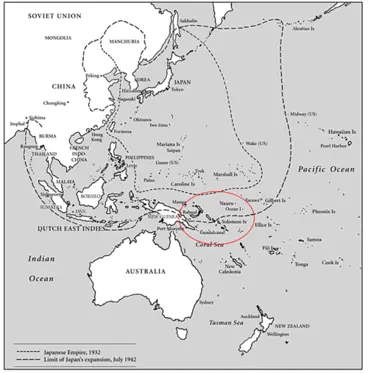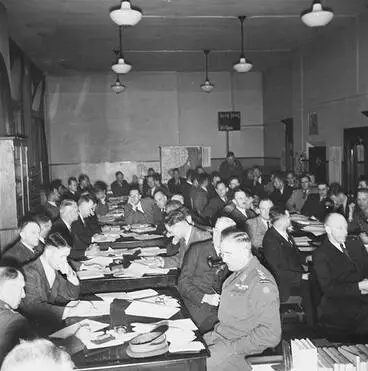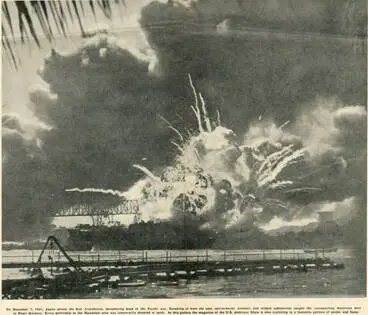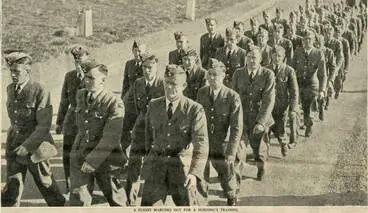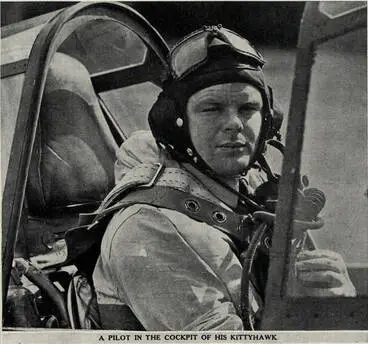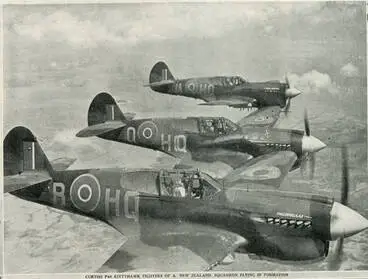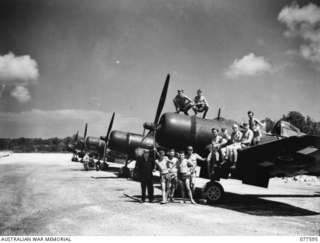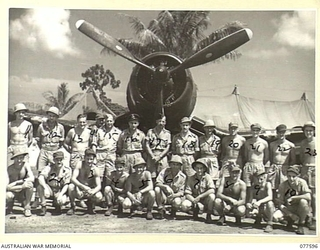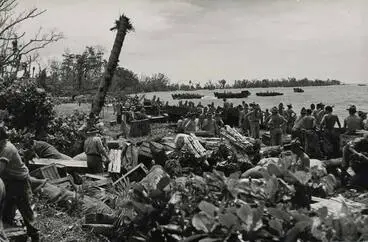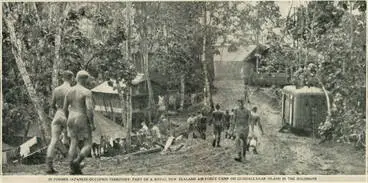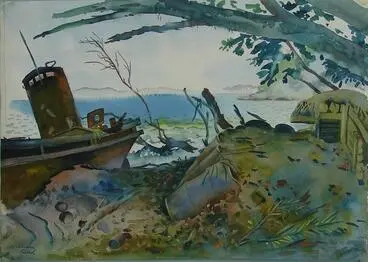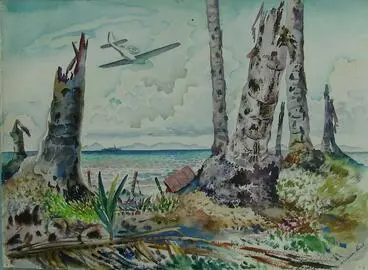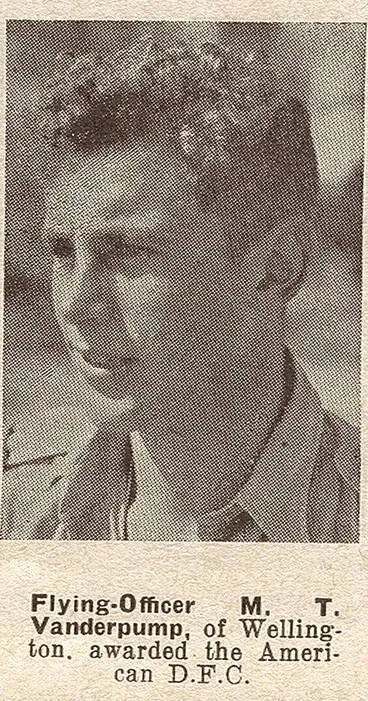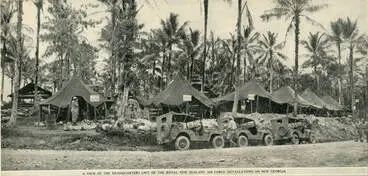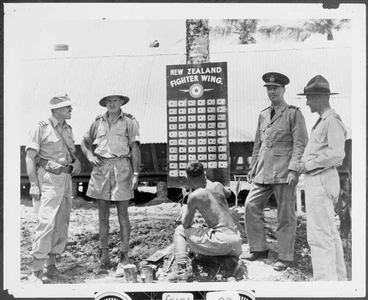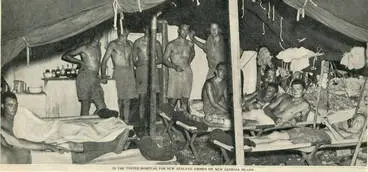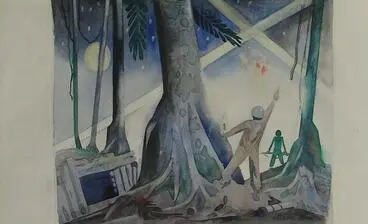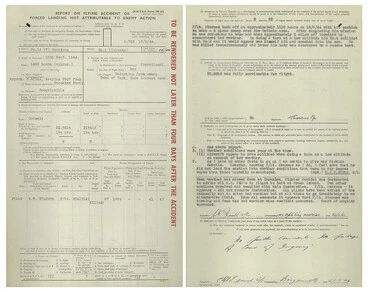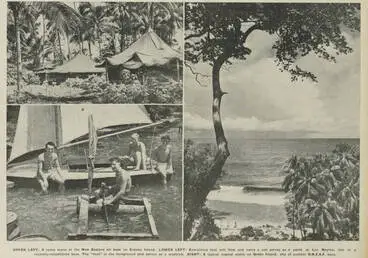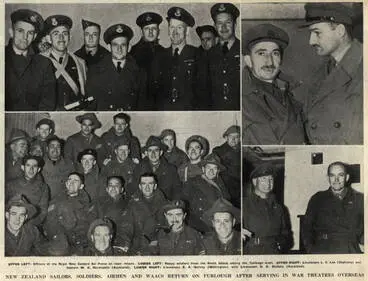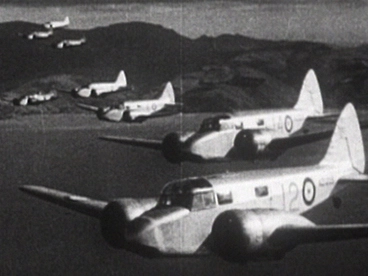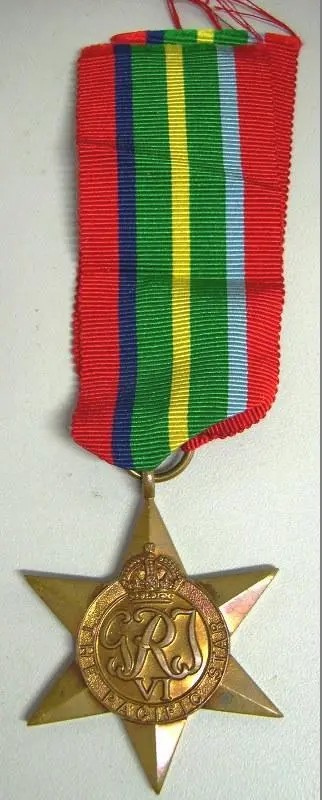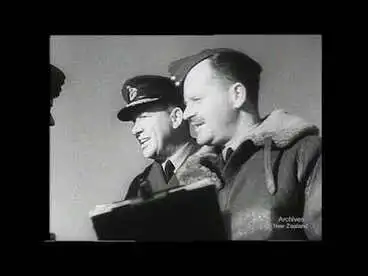Kiwis in Pacific War - No 16 Squadron RNZAF
A DigitalNZ Story by Zokoroa
During the Pacific War, RNZAF No. 16 Squadron operated from 1943 to 1945. This story commemorates the pilots and the ground crew who contributed to NZ's involvement in World War II.
WWII, World War Two, World War 2, Pacific War, RNZAF, Air Force, Military, Pilots, Guadalcanal, Solomon Islands, Espiritu Santo, 16th Squadron, Squadrons, Japan, Japanese, Aviation, Air Force Museum, History
RNZAF No. 16 Fighter Squadron In South Pacific, WWII
This story commemorates the air and ground crew of RNZAF No. 16 Fighter Squadron who served in the Pacific War arena from June 1942 - October 1945.
Map of Pacific Theatre
Manatū Taonga, the Ministry for Culture and Heritage
1. Piecing together information
Official War Histories:
Official war histories of NZ's involvement in the Second World War provide operational insights about the No. 16 Squadron, such as can be found in Royal New Zealand Air Force written by J.M.S. Ross (1955) and The Pacific written by O.A. Gillespie, (1952). Also see bibliographic list of all the Official War Histories for WWII.
Historians, military personnel and Department of Internal Affairs officials planning NZ official histories.
War histories: 1946 conference
Manatū Taonga, the Ministry for Culture and Heritage
Front Cover - Royal New Zealand Air Force
Victoria University of Wellington
Front Cover - The Pacific
Victoria University of Wellington
AIR Force Museum of New Zealand:
The national Air Force Museum for the RNZAF and NZ military aviation is located on the old Wigram Air Force Base on the outskirts of Christchurch. The Research and Development section holds the photographic archives for the RNZAF, documents and literature on the history of the service and Allied Air Forces. You can view historical displays and explore restored aircraft.
In Feb 2020, the Museum announced, "For the first time ever, the public can browse digitised parts of our photograph collection, online. Around 5,000 images are currently available, which represents an estimated 0.5% of the total collection. More images are being uploaded online every day to our Fotoware database." See: https://www.airforcemuseum.co.nz/photographs/
The RNZAF Official negative collection and photographs donated to the Museum have also been made accessible on DigitalNZ. You can also listen to a behind-the-scenes RNZ interview (25:43 mins) with Matthew O'Sullivan, the official 'keeper of photographs' at the Air Force Museum, held on 24 October 2023.
Air Force Museum of New Zealand at Wigram, Christchurch
Aircraft and memorabilia are displayed at the Museum, & digitised photographs can be viewed on DigitalNZ
Christchurch City Libraries
AUCKLAND WAR MEMORIAL MUSEUM'S ONLINE CENOTAPH:
The Auckland War Memorial Museum's Online Cenotaph has records of those who served New Zealand on active service from the 19th century onwards. A keyword search for '16 squadron' will retrieve several names listed on the Online Cenotaph. You can also search the database for the names or service number of individuals to find out their biographical and service details, or carry out a keyword search to see whether a record has been created. If you cannot locate a record for a person who should be recorded, you can fill out the Museum's form. You can also contribute information to an existing record. The information on the Cenotaph has been compiled from official military records, photographs, ephemera, publications including newspapers, and information provided by family members.
Auckland War Memorial Museum's Online Cenotaph
A search on DigitalNZ for '16 squadron' will retrieve several names listed on the Online Cenotaph
Museum of New Zealand Te Papa Tongarewa
2. Pacific War: The beginnings of 16 Squadron
After the Japanese attacked Pearl Harbor on 7 December 1941, New Zealand, Britain and the United States declared war on Japan a day later. NZ joined the American campaign in the Solomon Islands during 1942 - firstly, the Navy; then the Air Force and the 3rd Division of the Army. To help bolster its quota for the air defence, NZ developed a recruitment campaign; formed new squadrons, including No. 16 Squadron; and reorganised its flight training schools.
Pacific War Council included Walter Nash, NZ Minister to the U.S..
Sir Winston Spencer Churchill with F. D. Roosevelt and the Pacific Representatives to the Pacific War Council, Washington, D. C. [picture]
National Library of Australia
Recruitment poster (1941) for 16.5 yr - 18 yr old cadets. Age lowered to 16-18 years in March 1942.
New Zealand. Royal New Zealand Air Force. Air Training Corps :Join the N.Z. Air Training Corps; open to youths 16 1/2 to 18 years of age. E V Paul,...
Alexander Turnbull Library
Reorganisation of NZ flying training schools to keep up with quota of trained crew.
EFFECT OF PACIFIC WAR - Royal New Zealand Air Force
Victoria University of Wellington
A flight marches out for a morning's training
Auckland Libraries
Crew dressed for RNZAF flight training
Alexander Turnbull Library
3. RNZAF No. 16 SQuadron: JunE 1942 - October 1945
The No. 16 Fighter Squadron served in the Pacific war arena from June 1942 until it was disbanded in October 1945. It went through three evolutionary stages. Firstly, after the Squadron was formed, the crew undertook a period of training in NZ. Then the Squadron served overseas, initially to provide cover support for American bombers; then it graduated to carrying out its own bombing missions.
StaGe 1: Training NO. 16 SQUADRON (June 1842-June 1943)
> Ohakea Flight Training School: June 1942 - Aug 1942
No. 16 Squadron was formed at Ohakea in June 1942 where it commenced training commanded by Squadron Leader A. Jones.
Ohakea Airport
Alexander Turnbull Library
Trainee pilots learnt how to fly in Kittyhawks.
A pilot in the cockpit of his Kittyhawk
Auckland Libraries
> Fairhall Flight training school: Aug 1942 - June 1943
In August 1942, the Squadron relocated to Fairhall which was a satellite grass airfield to Woodbourne near Blenheim (See RNZAF Marlborough region map). This shift was to free up Ohakea for operational squadrons and the expected stationing of American forces. Also, by being based at Fairhall, the Squadron could provide fighter cover for shipping in the Wellington area whilst it completed its training. (Source: No. 16 Fighter Squadron (RNZAF): Second World War). The aircrew stayed at the adjacent Delta base which had a range of amenities: huts, tents, lecture blocks, movie theatre and other buildings (see Marlborough Express article Display tells of camp history, 26 April 2012).
Relocation of No. 16 Squadron to Fairhall, a satellite of Woodbourne (near Blenheim) in Aug 1942.
FORMATION OF OPERATIONAL UNITS - Royal New Zealand Air Force
Victoria University of Wellington
Fairhall was a satellite grass airstrip to Woodbourne.
Woodbourne Aerodrome, Marlborough District
Alexander Turnbull Library
helmet, flying
Auckland War Memorial Museum Tāmaki Paenga Hira
View of helmet and goggles worn by No. 16 Squadron pilots, 1943.
PR1346
Air Force Museum of New Zealand
No. 16 Squadron Harvard parked in front of the skeleton of a hangar at RNZAF Station Fairhall
DWHvd017
Air Force Museum of New Zealand
> FIGHTER PLANES: Kittyhawk and Corsair
The Squadron was equipped with Curtiss P-40 Kittyhawks (1942-44) and later with F4U Corsair fighters (1944-45). See Youtube video "No 16 Squadron RNZAF, Kittyhawk, 1942, New Zealand". Also see the video "New Zealand National Film Unit presents Weekly Review. N.Z. squadrons strike from Bougainville" which includes the British Pathé film of No 16 Squadron flying Kittyhawk IVs at Torokina. Bryan Cox has also compiled two PowerPoint displays: "Corsairs at Ardmore and the Solomons 1944-1946" and "The mighty corsair".
Kittyhawks flown 1942-44
Auckland Libraries
Line up of No. 16 Squadron Kittyhawks at RNZAF Station Gisborne
ALB090772924
Air Force Museum of New Zealand
No. 16 Squadron Kittyhawk NZ3044 XO-P in flight, possibly over the Marlborough coast, 1943
MUS090044
Air Force Museum of New Zealand
Corsairs flown 1944-45
Auckland War Memorial Museum Tāmaki Paenga Hira
Chance Vought F4U Corsair
Alexander Turnbull Library
> Air and Ground crew
A Squadron comprises a number of aircrew, ground crew and support personnel necessary to perform tasks at the base and when deployed. The records of those serving in the New Zealand Defence Force (NZDF) after 1920 are held at the NZDF Personnel Archives at the Trentham Military Camp, Wellington. An individual's History Sheet (see example) records brief personal details; next-of-kin information; date of enlistment, embarkation and discharge; dates and length of service spent at home and overseas; postings to military units; promotions, medal entitlements, decorations; and particulars of marriage and children’s details are also often recorded. You can also access the Auckland War Memorial Museum's Online Cenotaph for individual photos and records.
No. 16 Squadron Leader:
- June 1942–May 1943: A. N. Jones
- May–Sept 1943: J. S. Nelson
- Oct 1943–Jan 1944: J. H. Arkwright
- Jan–June 1944: A. G. Sievers
- June–Sept 1944: M. C. P. Jones
- Oct 1944–June 1945: P. S. Green
- July–Oct 1945 : J. H. Mills
L-R: Squadron Leader Nelson (16 Squadron) and Squadron Leader Willis (9 Squadron), circa 1943
PR1405
Air Force Museum of New Zealand
L-R: Flight Lieutenant Avery, Squadron Leader Green & Flight Lieutenant Gray - Bougainville, 1943
PR6361
Air Force Museum of New Zealand
FIGHTER PILOTS:
The photos of the following pilots are available on DigitalNZ. In addition, a keyword search for '16 squadron' will retrieve several names listed on the Auckland War Memorial Museum's Online Cenotaph.
Portrait of Clifford Owen Brady, IC, 16 Squadron
Alexander Turnbull Library
Portrait of J M Codlin, IC, 16 and 22 Squadrons
Alexander Turnbull Library
J R Holland, I.C, ex 16th, 22nd, 26th Squadron
Alexander Turnbull Library
Portrait of K H Harpin, IC, 16th Squadron
Alexander Turnbull Library
Portrait of J K Rogers, I C, 16-25 Squadrons
Alexander Turnbull Library
GROUND CREW:
When describing this photograph of a Corsair being overhauled by ground crew on Green Island, the Australian War Memorial added: "The service units were responsible for the maintenance and repair of all New Zealand aircraft in the area. The tropical climate made for particularly gruelling working conditions, exacerbated by long tours of duty – the limited availability of air transport to New Zealand, and the large numbers of ground crew stationed in the Solomons, meant it was impossible to rotate them out of the forward area as often as aircrew."
> ToURS of Duty: LOCATION & DATES
- New Zealand: June 1942 – June 1943
- Espiritu Santo: June–July 1943; November 1943 – July 1944; April 1945
- Guadalcanal: July –September 1943; March 1944; July – August 1944; November – December 1944
- New Georgia: November 1943 – January 1944
- Bougainville: March – May 1944; August – September 1944; April – June 1945
- Green Island: December 1944 – February 1945
- Jacquinot Bay: August – October 1945
NZ fighter squadrons usually spent six weeks in Espirito Santo before they were sent forward to the combat zone. They were relieved after six weeks in the combat zone and returned to New Zealand for rest and reorganisation.
Map of the Pacific theatre, 1941-1945
Manatū Taonga, the Ministry for Culture and Heritage
Summary of Tour of Duty: Location & dates
no. 16 fighter squadron - Royal New Zealand Air Force
Victoria University of Wellington
Stage 2: American Bomber support role (June - Oct 1943)
> JUNE - JULY 1943: ESPIRITU SANTO, New Hebrides (VANUATU)
A fortnight after taking final leave in June 1943, No. 16 squadron was flown to Espiritu Santo by transport planes and began operations there under the control of the American Interceptor Command. It flew on anti-submarine patrols and interception missions, investigating unidentified aircraft in the area, and also carried out operational training. (See excerpts from NZETC: Royal New Zealand Airforce.)
Group of No. 16 Squadron pilots on their first tour in front of a Kittyhawk at Espiritu Santo, July 1943
PR1422
Air Force Museum of New Zealand
NZ Governor General, Sir Cyril Newall, with Squadron Leader J H Arkwright (2nd left) at Espiritu Santo, Nov 1943
PR2050
Air Force Museum of New Zealand
Group of No. 16 Squadron pilots sitting on the wing of a Kittyhawk, 1943
PR1324
Air Force Museum of New Zealand
No. 16 Squadron pilot, Flight Lieutenant JH Arkwright, sitting on the nose of a Kittyhawk believed to be Espiritu Santo
PR1328
Air Force Museum of New Zealand
No. 16 Squadron pilot Flight Lieutenant J. R. Day standing on the wing of a P-40 Kittyhawk. Espiritu Santo, 1943
PR1445
Air Force Museum of New Zealand
RNZAF camp, Espiritu Santo, New Hebrides (Vanuatu)
Alexander Turnbull Library
Group of unidentified RNZAF airmen standing on a beach, Espiritu Santo, New Hebrides (Vanuatu)
Alexander Turnbull Library
Using a 'Cactus' stove, made from a kerosene tin and the tail section of an aerial bomb
PR1372
Air Force Museum of New Zealand
No. 16 Squadron personnel relaxing at an RNZAF camp believed to be Espiritu Santo, 1943
PR1486
Air Force Museum of New Zealand
> JULY - SEPT 1943: GUADALCANAL (Solomon ISLANDS)
On 17 July 1943, ten pilots from the No. 16 Squadron were flown to Guadalcanal in the Solomon Islands by transport plane and began operations the next day with No. 14 Squadron. The No. 14 Squadron had been involved in some intense fighting in early July after the American invasion of New Georgia. The rest of the No. 16 Squadron joined them on 25 July, commanded by Squadron Leader J. S. Nelson, to relieve No. 14 Squadron and enter the fight for New Georgia (Operation Toenails). They remained on Guadalcanal for two months escorting and providing cover for American bombers and attacking enemy shipping, particularly barges around the islands.
THE SOLOMONS
Victoria University of Wellington
Six 16 Squadron Curtiss P-40 Kittyhawks and a No. 9 Squadron Lockheed Hudson heading to Guadalcanal, 1943
PR1172
Air Force Museum of New Zealand
Arriving at Guadalcanal, 1943
Manatū Taonga, the Ministry for Culture and Heritage
Three P-40 Kittyhawks at Guandalcanal : digital image
Wairarapa Archive
RNZAF tent camp, Pacific theatre : digital image
Wairarapa Archive
Guadalcanal coast, Solomon Islands, at RNZAF (Royal New Zealand Air Force) Camp Kiwi
Alexander Turnbull Library
P-40 under repair on Guadalcanal : digital image
Wairarapa Archive
New Zealand airmen with damaged wing : digital image
Wairarapa Archive
Aircraft Recognition
Auckland War Memorial Museum Tāmaki Paenga Hira
Four No. 16 Squadron Kittyhawks and No. 9 Squadron Hudson NZ2079 in formation, 1943
PR1185
Air Force Museum of New Zealand
Group of Curtiss P-40 Kittyhawk aircraft flying in formation over ocean
Alexander Turnbull Library
JAPANESE CONTACT:
The Squadron's first major clash with the Japanese came on 1 July when eight aircraft were escorting a force of American SBDs and TBFs to Munda. A large Japanese force was detected after the American raid and No. 16 Squadron was ordered to intercept. The flight lost its formation as it attempted to gain height through a thin layer of cloud and was attacked by around thirty Zeros. Two aircraft were shot down and one of the pilots baled out and was later picked up from the sea by an American PT boat.
Japanese Foxhole, Guadalcanal
Dunedin Public Art Gallery
In August the Squadron's main role was to provide cover for bombing strikes on various targets and carry out routine patrols to search for enemy shipping. It also escorted B24s on photographic reconnaissance over a number of Japanese positions. In addition, it carried out searches for enemy barges moving supplies from southern Bougainville to the remnants of the Japanese force on New Georgia, and to the garrisons on Kolombangara, Vella Lavella, and Rekata Bay.
A Curtiss P-40 Kittyhawk aircraft in flight
Alexander Turnbull Library
Beach at Guadalcanal
Dunedin Public Art Gallery
Overview of Squadron at Guadalcanal.
NO. 16 SQUADRON - Royal New Zealand Air Force
Victoria University of Wellington
On 25 August, Flight Lieutenant Spurdle and Flight Sergeant Pirie set fire to a Japanese landing barge on the beach at Bambatana Mission on Choiseul Island. Then, heading down the coast, they strafed two camouflaged boats and a moored boat that had been used by the Japanese for evacuating troops from New Georgia. The following day five aircraft led by Flight Lieutenant Day strafed a small steamship and a 30-foot launch off Ganongga Island, setting fire to both vessels.
Wrecked Japanese ship, Guadalcanal, Solomon Islands
Alexander Turnbull Library
RNZAF PILOTS AWARDED AMERICAN DFC:
On 3 September eight aircraft acted as bottom cover to a force of B24s returning an attack on Kahili on Bougainville. On the way home two pilots, Flight Lieutenant Vanderpump and Flight Sergeant Miller, dropped back to cover a B24 which had been damaged and which was being attacked by eight to ten Zeros. They were successful in driving off the enemy aircraft and escorted the bomber safely back to its base. Both pilots were awarded the American DFC, the first time this was awarded to RNZAF personnel.
> Sept - Oct 1943: NZ Furlough & FLYING HOURS RECORD
After spending two months in Guadalcanal, No. 16 Squadron was relieved from the combat zone by No. 17 Squadron between 11 and 15 September. It returned to New Zealand for rest and reorganisation. As stated by Gillespie, "The periodical rotation of active squadrons made for greater efficiency and reduced sickness" (The Pacific, p.251 ). During its tour it had flown a total of 2100 hours, including 1260 operational hours for August, which was a record. (Source: J.M.S. Ross: Royal New Zealand Air Force, p.195.)
Parade of returned men and men on furlough, Wellington
Alexander Turnbull Library
Stage 3: FIGHTER-BOMBER MISSIONS (Nov 1943 - Oct 1945)
> Nov 1943 - JAn 1944: New Georgia (Solomon Islands)
In late November 1943, No. 16 under Squadron Leader Arkwright replaced No.18 Squadron in the RNZAF Fighter Wing, based at Ondonga on the west coast of New Georgia.
Servicing Unit aircraft maintenance area at Ondonga with Kittyhawk plane
PR2008
Air Force Museum of New Zealand
The New Zealand Fighter Wing scoreboard at New Georgia in the Solomon Islands, Nov 1943.
NZ Fighter Wing scoreboard, 1943
Manatū Taonga, the Ministry for Culture and Heritage
In the tented hospital for New Zealand airmen on New Georgia Island
Auckland Libraries
WAR IN THE PACIFIC (Evening Post, 06 December 1943)
National Library of New Zealand
FIRST FIGHTER-BOMBER MISSION: 11 DEC 1943:
On 11 December the RNZAF carried out its first fighter-bomber mission. This only involved three aircraft from the RNZAF Wing, each with two 100lb bombs and was an attack on a Japanese position at Kieta on Bougainville. A second fighter-bomber mission on 14 December resulted in the destruction of a bridge in the south-west of Bougainville.
BUSY DAY IN THE AIR (Evening Post, 30 December 1943)
National Library of New Zealand
ATTACK ON RABAUL (PAPUA NEW GUINEA): 17 Dec 1943:
On 17 December 1943 the Allies carried out their first large raid on Rabaul from Bougainville. Most of the aircraft involved were based on New Georgia, and staged through the new airfield at Torokina, Cape Augusta Bay. The RNZAF Fighter Wing provided twenty-four aircraft of the eighty that took part in this first attack. The New Zealanders claimed five Japanese fighters but lost two pilots, including the Wing Commander, T. O. Freeman. The Fighter Wing returned to Rabaul on 24 December when twelve Japanese aircraft were claimed for the loss of five pilots.
Attack on Rabaul
Group of No. 16 Squadron pilots with Kittyhawk '66' involved in first bomber assault on Rabaul
Air Force Museum of New Zealand
Briefing Pilots Before a Strike, 1944
Victoria University of Wellington
SERVICING UNIT, ONDONGA
Victoria University of Wellington
Bombing Up
Victoria University of Wellington
En Route
Victoria University of Wellington
Front Cover - The Assault on Rabaul. Operations by the Royal New Zealand Air Force December 1943 — May 1944
Victoria University of Wellington
Searchlight
Victoria University of Wellington
Bombing Rabaul
Victoria University of Wellington
BACK FROM RABAUL—First report to Intelligence Officer
Victoria University of Wellington
Bombs Gone
Victoria University of Wellington
Christmas in the Pacific 1943:
Christmas was spent in the Solomons with provisions supplied by the Patriotic Fund Board and entertainment provided by the Kiwi Concert Party. As stated by the Board Commissioner Major C. W, O. Brain, "...the per capita grant made from the patriotic funds to supply extras for the Christmas dinner, together with the .cost of patriotic gift parcels, the provision of Christmas cards, and amenities would represent a total expenditure of probably £20,000."
New Zealand National Patriotic Fund Board's store, Guadalcanal, Solomon Islands, during World War 2
Alexander Turnbull Library
> March 1944: Guadalcanal (SOLOMON ISLANDS)
Camp amenities:
Kiwi ingenuity was in evidence! An article in the Ellesmere Guardian entitled "Soldier's life in the tropics" (12 January 1943) commented, "Officers and men alike— there are no batmen here —are making the best of tent life by building "bush furniture" out of packing cases and odd scraps of timber, wooden flooring and walls, trellis fences and shingle paths".
ALB87017047
Air Force Museum of New Zealand
New Zealand military camp at Guadalcanal, Solomon Islands, during World War II
Alexander Turnbull Library
PR1281
Air Force Museum of New Zealand
Recreational pursuits:
As described in the Ellesmere Guardian article "Soldier's life in the tropics" (12 January 1943), popular leisure pursuits for NZ troops: included growing vegetables with packets of seed from NZ: "Quickly-growing vegetables like beans and peas, which will bring freshness to meals now almost completely prepared from tinned and preserved rations, taxing the cooks' ingenuity, are in highest favour. There are more ambitious experiments, too, in the form of tomato and onion plants raised from seed in boxes of fine soil…” Recreation huts were also established "where officers and men may read, write letters .and play indoor games in the evening. Occasionally they see motion pictures at a neighbouring American station or stage their own "campfire concerts," ...
PR6093
Air Force Museum of New Zealand
Female impersonator entertaining World War II troops in the Pacific
Alexander Turnbull Library
Medical facilities:
World War II surgical station, Guadalcanal, Solomon Islands
Alexander Turnbull Library
RNZAF medical section ward at Guadalcanal
Victoria University of Wellington
New Zealand nurses arriving in Guadalcanal, Solomon Islands, during World War 2
Alexander Turnbull Library
Combat MISSIONS:
GROUND STAFF CAMP ON BOUGAINVILLE, January 1944 — The airmen’s mess is in the background
Victoria University of Wellington
Air Raid, Guadalcanal
Dunedin Public Art Gallery
RNZAF Corsairs over Guadalcanal, 1944
Manatū Taonga, the Ministry for Culture and Heritage
Aircraft maintenance:
Maintenance No. 1 SU, [RNZAF Corsair], Henderson Field, Lunga Point, Guadalcanal
Archives New Zealand Te Rua Mahara o te Kāwanatanga
Corsair maintenance, Guadalcanal
Archives New Zealand Te Rua Mahara o te Kāwanatanga
Airing parachutes, Guadalcanal
Archives New Zealand Te Rua Mahara o te Kāwanatanga
> March - May 1944: Bourgainville (Papua New Guinea)
In March-May 1944 the Squadron formed part of the RNZAF Fighter Wing on Bougainville and carried out a series of attacks on Japanese targets on Bougainville and around Rabaul. Moving to Bougainville saved the pilots up to three hours flying on each operation as they no longer had to do the return trip to the Ondonga airstrip at New Georgia. Instead of leaving their base at dawn and returning late in the afternoon, they were now able to take off about eleven in the morning and be home again by 3 pm. Apart from the saving in flying time, the hazard of bad weather between Torokina and Ondonga was now eliminated.
KITTYHAWK LANDING, BOUGAINVILLE
Victoria University of Wellington
RNZAF personnel lining up at canteen for a beer (Waitemata Pale Ale)
PR2948
Air Force Museum of New Zealand
On the morning of 14 April 1944, twelve aircraft of No. 16 Squadron flew on a mission to join No. 19 in an attack on an ammunition dump south of Rataval, near Rabaul. They reached Rabaul an hour after No. 19, by which time the weather had cleared over Rataval, and dropped all their bombs in the target area. In the afternoon twelve aircraft took off again and bombed and strafed Japanese-occupied huts on the north-east coast of Bougainville. They demolished two of the huts by bombing and set another on fire by strafing. The Squadron's flying time for the day was fifty hours. (See NZETC: Royal New Zealand Air Force)
> July-August 1944: Guadalcanal (Solomon Islands)
Furlough back at NZ
No. 16 Squadron personnel in front of a Kittyhawk. RNZAF Station Ardmore, June 1944
Air Force Museum of New Zealand
John Coom at Operations Room, Guadalcanal : digital photograph
Wairarapa Archive
Arming 1 S.U. Corsair. Guadalcanal.
Auckland War Memorial Museum Tāmaki Paenga Hira
Views of 1 S.U. Corsairs in flight. Guadalcanal - 1944.
Auckland War Memorial Museum Tāmaki Paenga Hira
> August-September 1944: Bougainville (Papua New Guinea)
In August and September 1944 the Squadron was based on Bougainville where it provided part of the air defence of Empress Augusta Bay and flew fighter-bomber sweeps across the Japanese occupied part of the island as well as out towards Rabaul. British Pathé has a video (called N.Z. Air Strikes) which shows 16 & 17 Squadron Kittyhawk IVs at Torokina and 25 Squadron Dauntlesses and 30 Squadron Avengers at Piva, all in action over Bougainville in early 1944.
RNZAF medical section, Bougainville
Victoria University of Wellington
Group of No. 16 Squadron Section Leaders during the squadron's third tour. Torokina, Bougainville, 1944
PR3980
Air Force Museum of New Zealand
Group of No. 16 Squadron personnel on the squadron's third tour - Torokina, Bougainville, 1944
PR3977
Air Force Museum of New Zealand
RNZAF Crash Reports, Torokina, Bougainville (1944)
Archives New Zealand Te Rua Mahara o te Kāwanatanga
> Nov-Dec 1944: Guadalcanal (Solomon Islands)
Old Number Thirteen. Quadalcanal.
Auckland War Memorial Museum Tāmaki Paenga Hira
"Strike Flight" waiting. No. 1 S.U. Quadalcanal - Nov. 1944.
Auckland War Memorial Museum Tāmaki Paenga Hira
> DEC 1944 - FEB 1945: GREEN ISLAND (NEW GUINEA)
On 21 December 1944 No. 16 Squadron joined No. 14 Squadron on Green Island, between Bougainville and New Ireland. The two Squadrons had several tasks - to provide a standing patrol over Rabaul, to escort 'Dumbo' air-sea rescue aircraft, to fly dawn and dusk patrols over the local area, to maintain four aircraft ready to scramble to intercept any Japanese raids and to fly offensive sweeps across the Japanese occupied areas of New Britain and New Ireland. The Squadrons shared this role until January 1945, when No. 14's tour in the Tropics ended. No. 16 Squadron remained on Green Island until it was relieved by No. 15 Squadron in February 1945 and returned to New Zealand.
Over Green Island
Victoria University of Wellington
Base scenes in the Pacific
Auckland Libraries
Black MondAy, 15 Jan 1945 - 8 pilots Lost:
Attack on Toboi & Attempted rescue of downed pilot:
On Monday, 15 January 1945, Nos. 14 and 16 Squadrons flying from Green Island and No. 24 from Bougainville carried out a strike at midday on Toboi Wharf in Simpson Harbor at Rabaul. Of the 36 corsairs involved, one was hit by anti-aircraft fire. The pilot Flight Lieutenant Keefe of No. 14 Squadron had to bail out into the harbour and he swam towards the harbour entrance. Aircraft from the squadrons provided air cover for six hours and dropped two bamboo rafts assembled on Green Island but Keefe was unable to reach the rafts. The corsairs were then forced to return to base when their fuel ran low. After the war, it was reported by Japanese troops captured at Rabaul that Keefe had managed to swim ashore with a wounded arm after spending nine hours in the water. He was taken prisoner and died of blood poisoning on 30 Jan 1945, according to his Cenotaph record.
Vought F4U Corsair aircraft, Bougainville, Papua New Guinea, during World War II
Alexander Turnbull Library
Seven MISSING AIRCRAFT & PILOTS:
After their attempted rescue of Keefe, the corsairs returned to base keeping in close formation as darkness had fallen. They flew into a tropical storm with lightning strikes and heavy rain. Five aircraft crashed into the sea, a sixth crashed on Green Island and a seventh disappeared. None of the missing aircraft or their crews were found. The lost pilots were: Flight Lieutenant T.R.F. Johnson, Flight Officer G. Randell, and Flight Sergeant R.W. Albrecht from No. 16 Squadron; and Flight Lieutenant L. B.S. Hay, Flight Officer A.N. Saward, Flight Sergeant I.J. Munro, and Flight Sergeant J.S. McArthur from No. 14 Squadron.
EIGHT PLANES LOST (Evening Post, 01 February 1945)
National Library of New Zealand
For more detailed accounts of Black Monday, see: Evening Post article "War in the Pacific" (19 Jan 1944); Warefare History Network's "Kiwis over the Pacific" and Ross, J. M. S., Royal New Zealand Air Force (1955, pp. 301-304). Also see the personal recount by Bryan Cox in his PowerPoint display "Green Island revisited 2011".
> February - MArch 1945: FURLOUGH IN NZ
After being on Green Island since 21 Dec 1944, No. 16 Squadron was relieved by No.15 Squadron in February 1945. Like other NZ military units, it returned to New Zealand for a period of furlough. See photo taken of No.16 Squadron at Ardmore during March 1945.
Group of No. 16 Squadron personnel, for the 6th Tour of Duty, in front of a Corsair. RNZAF Station, Ardmore, March 1945
PR5471
Air Force Museum of New Zealand
> APRIL 1945: ESPIRITU SANTO, NEW HEBRIDES (VANUATU)
> April-June 1945: Bougainville (Papua New Guinea)
In April 1945 the squadron was one of four RNZAF squadrons that moved to Bougainville, when the number of fighter squadrons was doubled from two to four. See photo taken of No. 16 Squadron at the Piva airstrip with Squadron Leader Paul Green. The squadrons arrived just as the chain of command on Bougainville was improved. Before April all requests for air support went from the 2nd Australian Corps to the Commander, Air, North Solomons, who then issued orders to the RNZAF. From April a direct link was established between the Australians and the RNZAF.
All four squadrons had to provide dawn and dusk patrols to guard against any possible Japanese air attacks. They were also used for ground attack missions, attacking tactical targets close to the Australian lines, troop concentrations behind the lines and targets around the main Japanese bases. In April the four squadrons flew an average of 50-60 sorties per day. Three incidents of pilots taking off on bombing strikes and experiencing mechanical problems are recounted by Bryan Cox in a PowerPoint display : "The last survivor: RNZAF Corsair NZ5394". For additional photographs about the Squadron on Bourgainville - aerial operations, camp life, recreational activities and concert party performances by Bob Hope and Jack Benny - see PowerPoint photos by Bryan Cox, "Bourgainville & Jacquinot Bay".
No. 16 Squadron Corsair NZ5482, that was flown by Flight Sergeant Wiig, lying in the scrub beside the runway
ALB901711014
Air Force Museum of New Zealand
Pallikulo airstrip, Espiritu Santo, Vanuatu
Alexander Turnbull Library
In June 1945 No. 16 Squadron was relieved by No. 23 Squadron as part of a wider move in which all four fighter squadrons were replaced.
> Aug-Oct 1945: Jacquinot Bay, New Britain (Papua New Guinea)
In mid-August 1945 No. 16 Squadron relieved No. 20 Squadron at Jacquinot Bay on New Britain. The Squadron was used to fly security patrols over the Gazelle Peninsula (including Rabaul). For additional photos, see slides 55 - 103 in Bryan Cox's PowerPoint, "Bourgainville & Jacquinot Bay".
R.N.Z.A.F. MOVES IN (Evening Post, 23 July 1945)
National Library of New Zealand
SIGNS OF YIELDING (Evening Post, 22 August 1945)
National Library of New Zealand
OVER RABAUL (Evening Post, 10 September 1945)
National Library of New Zealand
CATALINAS KEPT BUSY (Evening Post, 26 September 1945)
National Library of New Zealand
AIRMEN RETURN (Evening Post, 06 November 1945)
National Library of New Zealand
> JAPAN SURRENDERS: 15 AUGUST 1945
The surrender of Japan was announced on 15 August and formally signed on 2 September 1945. Also see photos and an account by Bryan Cox, one of the No. 16 Fighter pilots: https://www.corsairsandkittyhawks.com/japanese-surrender-at-rabaul As part of the Allied Forces' celebration, a Victory Cup Race meeting was held on 23 August at Jacquinot Bay. Wooden horses were raced on the airstrip with movement determined by the throw of dice.
Formal signing of the Japanese Instrument of Surrender on board USS Missouri, 15 August 1945.
Japanese Instrument of Surrender on board USS Missouri
Tauranga City Libraries
Instrument of surrender : photograph
Wairarapa Archive
JAPS GIVE IN (Evening Post, 07 September 1945)
National Library of New Zealand
STAGE 4: No. 16 Squadron disbanded (October 1945)
According to Bryan Cox, "Being nearest to Rabaul, No 16 Squadron was the last squadron to return to New Zealand, and we departed on 30/10/1945 in a formation of 16 Corsairs, with our first stop 580 miles to the south of Guadalcanal. Before we were even airborne, the bulldozers were at work." (see photo). They flew southwards to Henderson Field where they stayed two nights; then arrived at Rukuhia on 5 November 1945. See Bryan Cox's Slide 103 and Slide 104.
R.N.Z.A.F. IN PACIFIC (Evening Post, 22 November 1945)
National Library of New Zealand
Discharge Certificate (WWII) for Airman R.S. Laurie (1921-2004)
Tauranga City Libraries
U.S. Commander George C. Kenny, in a letter to the New Zealand Chief of Air Staff, Air Vice Marshall L. M. Isitt, expressed appreciation of the part played by the Royal New Zealand Air Force in the Pacific war: "It is with deep gratitude for your magnificent co-operation that I send my last message as commander of the Allied Air Forces in the Pacific… For nearly four years we faced some of the toughest going any of. our nations ever experienced:… Looking back, we can see that the Japanese capitulation was largely brought about by the sustained Allied air offensive ….Each of you has fought courageously and unselfishly to restore peace among nations and freedom and justice to men everywhere.”
Black and white photograph of anti aircraft guns
Victoria University of Wellington
Extent of the Japanese invasion shown in the maps available on Te Ara.
The war in the Pacific
Manatū Taonga, the Ministry for Culture and Heritage
Timeline of key dates and events that occurred during the Pacific War
Pacific War Timeline - War in the Pacific
Manatū Taonga, the Ministry for Culture and Heritage
JAPANESE WAR IN RTROSECT NEW ZEALAND'S SHARE IN PACIFIC WAR (Evening Post, 16 August 1945)
National Library of New Zealand
4. Commemorating No. 16 Squadron crew
ROLL OF HONOUR:
NZ newspapers printed a Roll of Honour with the names of air personnel who were casualties - killed in action, missing and. presumed dead, or died of injuries.
battledress blouse
Auckland War Memorial Museum Tāmaki Paenga Hira
ROLL OF HONOUR (Evening Post, 27 February 1945)
National Library of New Zealand
5. Further information
- Air Force Museum of New Zealand Photographic Collection. (You can search their photographic database)
- Auckland War Memorial Museum's Online Cenotaph has records of those who served NZ since the 19th Century.
- Bryan Cox's website with powerpoint photos: https://www.corsairsandkittyhawks.com/
- Cox, Bryan (1987). Too young to die: The story of a New Zealand fighter pilot in the Pacific War (Century Hutchinson)
- Cox, Bryan (b.1997). Pacific Scrapbook 1963-1947: a pictorial history of a young New Zealand Corsair pilot in the Pacific and Japan and of Allied co-operation in the Pacific War (Auckland: McGraw Hill)
- Cox, Bryan (2004). "Cats have only nine lives: memorable moments in the air, 1943-1993" (Tauranga: B.Cox)
- Gillespie, O.A. (1952). The Pacific (Wellington: Historical Publications Branch) Part of: The Official History of New Zealand in the Second World War 1939–1945
- 'New Zealanders in the Pacific War', URL: https://nzhistory.govt.nz/war/war-in-the-pacific, (Ministry for Culture and Heritage), updated 31-Aug-2020
- Rickard, J. (14 June 2013). No. 16 Fighter Squadron (RNZAF): Second World War
- Ross, J.M.S. (1955). Royal New Zealand Air Force (Wellington: Historical Publications Branch) Part of: The Official History of New Zealand in the Second World War 1939–1945
- Wings over New Zealand Forum meetings which include Youtube presentations by Bryan Cox (14 June 2013): Part 1, Part 2, & Part 3.
- Wings over New Zealand Show aviation podcast. Episode 8: Bryan Cox
Also see the following New Zealand National Film Unit's documentaries about the RNZAF in the Pacific during 1943, which are held by Archives New Zealand:
(This DNZ story was first created in January 2019, and updated in November 2023)
